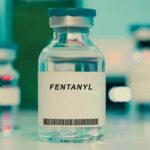Fentanyl may taste like sugar when in powder form or when taken on its own. Some case studies attribute a sweet taste to fentanyl because of lactose or sugar present. Other reports suggest fentanyl can be tasteless.
The taste and overall presence of fentanyl can be masked in other drugs. Fentanyl is a popular ingredient in illicit drug mixtures of heroin, cocaine, Xanax, and other opiates. A person buying illegal drugs may be unaware they are taking fentanyl.
Fentanyl’s unassuming appearance and taste, combined with its potent effects, make it a dangerous synthetic opioid. In recent years, fentanyl has contributed to more opioid overdose deaths than any other drug.
Fentanyl Taste
Fentanyl may take on the taste of the drugs or adulterants it is mixed with. For example, an illicit heroin mixture may contain fentanyl, sugar, caffeine, and flour. The overall taste of this mixture may be bitter, sweet, or tasteless.
Another type of fentanyl is liquid fentanyl. Liquid fentanyl may have tasteless properties similar to its powder form.
Fentanyl Identification
The powder form of fentanyl may be identified by its light brown or white appearance. Fentanyl may also take the form of a light yellow liquid when it is mixed with heroin.
In powder form, fentanyl may be mixed into painkillers, methamphetamines, and other drugs, where it takes on their appearance. Powder fentanyl can even take on the appearance of other prescription opioids, like oxycodone. Liquid fentanyl may be hidden in paper strips or lozenges.
It can be difficult to identify fentanyl until after it is taken. Fentanyl can be up to 50 times stronger than heroin and 100 times stronger than morphine. The risk of overdose when taking fentanyl without knowing can be significant.
Risk Of Fentanyl Overdose
Fentanyl’s attributes can cause a person to reach the fatal overdose threshold without knowing. Symptoms of drug overdose due to fentanyl include:
- respiratory depression (slowed or stopped breathing)
- blue lips or fingernails
- lack of a pulse
- vomiting or gurgling
- unconsciousness or coma
Fentanyl test strips can be an effective form of overdose prevention. These strips can detect fentanyl in unregulated drugs, and some harm reduction programs distribute them for free.
Naloxone is an accessible nasal spray (Narcan) that blocks opioid receptors and reverses symptoms of opioid overdose.
Treating Fentanyl Abuse & Addiction
Illicit drug use involving fentanyl may be a sign of a substance use disorder. Fentanyl’s habit-forming and potent nature can cause withdrawal symptoms, cravings, and rebound chronic pain. It can be difficult to quit without professional help.
Fentanyl addiction treatment programs can reduce physical dependency on the drug over time. They can also teach patients valuable coping skills and habits so they can avoid future relapses.
Detox, behavioral therapy, methadone, and mental health services are common aspects of opioid addiction treatment.
To find out if our outpatient opioid addiction treatment program works for you or your loved one, please contact us today.
Sources
Written by
Northeast Addition Editorial Team
©2024 Northeast Addition Center | All Rights Reserved
This page does not provide medical advice.



